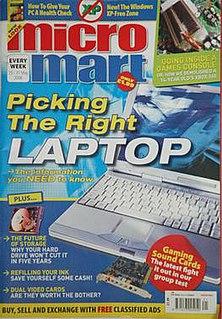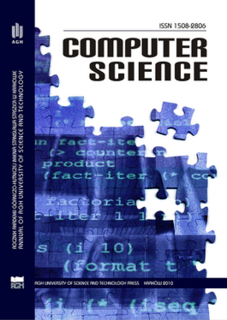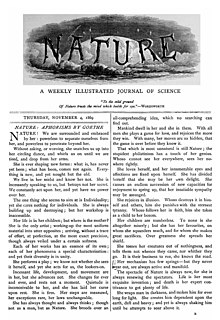
New Scientist, first published on 22 November 1956, is a weekly, English-language magazine that covers all aspects of science and technology. New Scientist, based in London, publishes editions in the UK, the United States, and Australia. Since 1996 it has been available online.

Nature is a British multidisciplinary scientific journal, first published on 4 November 1869. It is one of the most recognizable scientific journals in the world, and was ranked the world's most cited scientific journal by the Science Edition of the 2010 Journal Citation Reports and is ascribed an impact factor of 40.137, making it one of the world's top academic journals. It is one of the few remaining academic journals that publishes original research across a wide range of scientific fields.
Computer magazines are about computers and related subjects, such as networking and the Internet. Most computer magazines offer advice, some offer programming tutorials, reviews of the latest technologies, and advertisements.
Academic publishing is the subfield of publishing which distributes academic research and scholarship. Most academic work is published in academic journal article, book or thesis form. The part of academic written output that is not formally published but merely printed up or posted on the Internet is often called "grey literature". Most scientific and scholarly journals, and many academic and scholarly books, though not all, are based on some form of peer review or editorial refereeing to qualify texts for publication. Peer review quality and selectivity standards vary greatly from journal to journal, publisher to publisher, and field to field.

An academic or scholarly journal is a periodical publication in which scholarship relating to a particular academic discipline is published. Academic journals serve as permanent and transparent forums for the presentation, scrutiny, and discussion of research. They are usually peer-reviewed or refereed. Content typically takes the form of articles presenting original research, review articles, and book reviews. The purpose of an academic journal, according to Henry Oldenburg, is to give researchers a venue to "impart their knowledge to one another, and contribute what they can to the Grand design of improving natural knowledge, and perfecting all Philosophical Arts, and Sciences."
Scientific literature comprises scholarly publications that report original empirical and theoretical work in the natural and social sciences, and within an academic field, often abbreviated as the literature. Academic publishing is the process of contributing the results of one's research into the literature, which often requires a peer-review process. Original scientific research published for the first time in scientific journals is called the primary literature. Patents and technical reports, for minor research results and engineering and design work, can also be considered primary literature. Secondary sources include review articles and books. Tertiary sources might include encyclopedias and similar works intended for broad public consumption.

Your Sinclair, or YS as it was commonly abbreviated, was a British computer magazine for the Sinclair range of computers, mainly the ZX Spectrum.
Mathematical Reviews is a journal published by the American Mathematical Society (AMS) that contains brief synopses, and in some cases evaluations, of many articles in mathematics, statistics, and theoretical computer science. The AMS also publishes an associated online bibliographic database called MathSciNet which contains an electronic version of Mathematical Reviews and additionally contains citation information for over 3.5 million items as of 2018.

Micro Mart was a weekly computer magazine published in the United Kingdom by Dennis Publishing Ltd.. As of 2015, it had a circulation of 5,422. In a letter to subscribers in December 2016 it was announced that the magazine would cease publication with issue No 1445 : "After 30 amazing years of telling it like it is, Micro Mart magazine is logging off."
Scientific writing is writing for science.
Index Medicus (IM) is a curated subset of MEDLINE, which is a bibliographic database of life science and biomedical science information, principally scientific journal articles. From 1879 to 2004, Index Medicus was a comprehensive bibliographic index of such articles in the form of a print index or its onscreen equivalent. Medical history experts have said of Index Medicus that it is “America's greatest contribution to medical knowledge.”
Progress in Physics is an open-access academic journal, publishing papers in theoretical and experimental physics, including related themes from mathematics. The journal was founded by Dmitri Rabounski, Florentin Smarandache, and Larissa Borissova in 2005, and is published quarterly. Rabounski is the editor-in-chief, while Smarandache and Borissova act as associate editors.
The Journal of Cell Science is a peer-reviewed scientific journal in the field of cell biology. The journal is published by The Company of Biologists with 24 annual issues.
Today in China, there are more than 8,000 academic journals, of which more than 4,600 can be considered scientific. About 1,400 cover health science.

FEBS Letters is a not-for-profit peer-reviewed scientific journal covering all aspects of molecular biosciences, including molecular biology and biochemistry. The aim of the journal is to publish primary research in the form of Research Articles, Research Letters, Communications and Hypotheses, as well as secondary research in the form of Review articles. The journal also publishes a News and Views column called "The Scientists' Forum". The editorial office of FEBS Letters is based in Heidelberg, Germany. FEBS Letters is published by Wiley on behalf of the Federation of European Biochemical Societies (FEBS). The journal income is reinvested in science.

Astronomy & Geophysics (A&G) is a scientific journal and trade magazine published on behalf of the Royal Astronomical Society (RAS) by Oxford University Press. It publishes a mixture of content of interest to astronomers and geophysicists: news reports, interviews, topical reviews, historical investigations, obituaries, meeting reports and updates on the activities of the RAS. Full-length articles are peer reviewed.

Computer Science is a peer-reviewed scientific journal published by the AGH University of Science and Technology and edited by faculty members of the Departments of Computer Science and Automatics. The journal was established in 1999 and since beginning of 2012 is published quarterly. The editor-in-chief is Jacek Kitowski.
Scholarly peer review is the process of subjecting an author's scholarly work, research, or ideas to the scrutiny of others who are experts in the same field, before a paper describing this work is published in a journal, conference proceedings or as a book. The peer review helps the publisher decide whether the work should be accepted, considered acceptable with revisions, or rejected.













